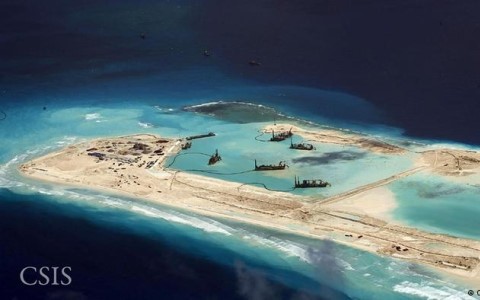(VOVworld) – The East Sea has been a hotly debated issue since the Permanent Court of Arbitration (PCA) issued its ruling on the Philippine lawsuit against China’s territorial claim. The ruling reflects a new regional order in which the rule of law is respected.
 |
| A shoal in the East Sea was illegally built up by China (Photo: CSIS) |
In its 500-page ruling, the PCA, established under the United Nations Convention on the Law of the Sea (UNCLOS), says China’s “nine-dash line” claim is groundless and rejected China’s “historical rights” over the East Sea. The ruling makes clear that artificial islands built up by China on shoals and coral reefs are not considered lawful entities entitled to an Exclusive Economic Zone (EEZ) extending 200 nautical miles from the shore or territorial waters, extending 12 nautical miles from the shore.
The PCA ruling is the first by an international court based on UNCLOS. Experts say that whether the ruling is enforced or not is less important than declaration that China’s claim to most of the East Sea has no legal basis. The ruling could pave the way for a long-term solution to current East Sea disputes.
International attention
Many countries have shown their support for and called for compliance with the PCA ruling, citing the legality of the ruling, which supports freedom of navigation, overflight, and unobstructed trade on the basis of international laws, including the 1982 UNCLOS. The international community wants disputes resolved through peaceful means without use or threat of force and with restraint from any acts that would escalate disputes and undermine peace and stability. Transportation routes through the East Sea play a crucial role in maintaining peace, stability, prosperity, and development. Parties involved have been urged to fully respect UNCLOS, which was created to protect the maritime rights of all countries.
Since the PCA ruling, the East Sea has been widely and high on the agenda of major multilateral forums like G7 and APEC.
Escalating military actions
The PCA ruling has led to policy adjustments by world powers. The second half of this year saw a series of military exercises in the East Sea. Defiant of international condemnation, China has insisted on building artificial islands and conducting a series of military exercises near Spratly islands and the Scarborough Shoal, both named in the PCA ruling.
The US deployed aircraft carriers and destroyers to joint military exercises with Japan, India, and other allies. US destroyers have frequently patrolled islands illegally occupied by China. Observers say the East Sea has seen the largest confluence of armed forces since the Vietnam War in 1975.
Although it will take a long time for the region to stabilize, the PCA ruling has created a focus for parties working together to defuse current tensions. Respecting UNCLOS is ultimately in the interest of all countries.